General care
Products sale at GNJ are very careful inspected at each and every stage of manufacturing such as scratch protection, long lasting, to ensure the superior quality. However; not only using caution and common sense to protect your jewelry but to make sure it is clean, repaired, stored and packaged in a proper manner will keep your jewelry longer sparkle, shine and lasting. If you need professional attention on jewelry care please email customerservices@gnj.com.vn or direct call (083) ...– .....
Cleaning, Inspection and Services
Cleaning and inspecting your jewelry regularly is one of the best things to keep your jewelry luster, sparkling, shining and also avoiding breaks, damages and loosing stones in advance. Please visit GNJ stores every six months for free cleaning and inspecting.
Diamond
Even diamonds are known as the hardest mineral to man but they require delicate care. It can be clean in a mild ammonia or soap and cold water. Soak your jewelry for several minutes then use a soft-bristled non-metallic brush and gently scrub away any dirt, especially around the prongs or setting where dirt buildup. Dry with a lint-free cloth. Note: If use jewelry cleanser make sure it is non-abrasive, don’t use harsh chemical cleanser, don’t clean jewelry in the sink it often end up down the drainpipe.
Gemstones
Each gemstone has unique color and quality so different care will apply for each gemstone. Most of gemstones may have been colored, clarity treated by heat, irradiation, oil, wax, resin, diffusion, fissure-filled. Heated and irradiated stones generally don’t require special care when cleaning, but diffused stones could become lighter if scrubbed too hard. Also, the oil on an emerald can be stripped away by cleaning, making the emerald change appearance.
Pearls
The nacre on surface of pearls is soft and easy to damage, but pearl is elegance and beautiful. Due to pearl is an organic compound so they also are easily dulled or even eaten away by chemicals and alcohol. It should be wiped with a clean, damp cloth after each used to remove build-up dirt and oil or wash cultured pearls in very mild, soapy water and nothing else. It's also a good idea to bring your cultured pearls in for restringing every couple of years, especially if you wear them often.
Metal
It is important to remember that care is different for every metal. Platinum is strong but is susceptible to scratches. To remove build-up with jewelry cleaner or mild soap and water. Gold is another type of metal that need gentle care. Soap, water and soft brush will take care most of cleaning needs. Make sure the brush is very soft when used on gold which can be scratched easily. Placing gold jewelry in a solution containing a few drops of ammonia, mild detergent and warm water will bring back sparkling and shining. You can also use rubbing alcohol to remove grease and body oil from gold jewelry.
Ultrasonic Cleaners
Ultrasonic cleaners are the machines which have been researched and accepted as a good way of cleaning. It uses sound waves and vibration to shake off dirt but the vibrations can cause serious damage to soft gems like pearl, emerald. Emerald is brittle; shaking stone may enlarge the inclusion and making the stone less attractive and less valuable. Therefore; we recommended using ultrasonic machine with care.
Sizing
It's important that your ring fit comfortably on your finger. If it is too tight it will cause irritation, may clog your artery. If it is too loose then you may lost your ring. We suggest measuring your size carefully with trained staffs before placing order because some rings are easy to size and some rings are not or may not be sizable at all.
Repairing
GNJ recommend you to schedule for cleaning and inspecting jewelry minimum once a year to find signs of wear such as loose stone mounting, damaging clasps or damaging prongs and fix them before serious problem. Do not repair your own jewelry unless you have been professionally trained.
Storage
Your jewelry may suffer damages if it is not stored properly. So it is very important to store jewelry without contacting with each other because diamonds, gemstones can easily scratch softer precious stones included gold, platinum. Each piece of jewelry should be wrapping or put in separate compartments in jewelry box. Be extra careful with pearl since it soft and scratches easier than other gems or metals.
Wearing
Proper care when start wearing your jewelry on or off is very important. Always put jewelry on after make up, perfume and hairspray because chemical, alcohol can build up over time and dull their appearance. Always, remove jewelry when start doing manual labor, housework, hair styled. Diamond and Gems can chip and crack if knocked against hard surface. Bracelet can be easily damage, bent if catches on hook. Suggesting that you should wear jewelry on your left wrist if you are right-handed since you don’t use much of left hand as right hand.
Lifetime Guaranteed Trade-In
GNJ will be very happy to accept trade-in with all products purchased from GNJ. Please ask staffs for information.
Warranty Conditions
GNJ will provide limited warranty applies to all bracelets, earrings, pendants, rings, necklaces. This commitment will only cover normal wear and only diamonds or gemstones in their original settings that have been inspected and repaired by GNJ.
Diamond
Diamonds are composed of pure carbon and are formed in between the crust and the core. The depth combines with extreme heat and pressure is necessary to form diamonds. In general, the shallowest depth at which diamonds form is 93 miles, or 150 kilometers, below the Earth's surface. Scientists and geologists have estimates that diamonds can take from several thousands to millions of yeas to form, depending on changing heat and pressure conditions. The intense heat and pressure account for the hardest substance on Mohr's scale. Diamonds are mined in Africa, Australia, Brazil, Russia and Canada.
Diamonds are brilliance, elegance, and purity so it is very expensive. Take a moment to learn about the qualities that contribute to the beauty of diamonds so you can select the perfect diamond, at best prize for the one you love.
Shapes:
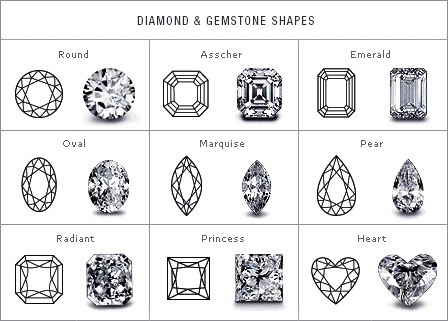
Flourescence:
Diamonds have unique properties including natural blue fluorescence under any source of ultraviolet light. The value of diamonds will base on how diamond reacts to UV. Stronger (None, Medium, Strong) fluorescence then less value of diamonds.
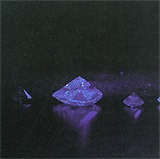
Four C's:
Diamonds are graded using a universal grading system that judges the stone’s quality, value base on color, clarity, cut and carat weight - commonly known as the "four C's." Please notice diamonds are honorable for its best value if purchase with world’s prestige grading named such as GIA, IGI, and AGS.
Diamonds formed deep within the earth, under extreme heat and pressure. Therefore; they often contain unique birthmarks, internal inclusion or external blemish. It is extremely rare for diamonds without sign of inclusions. Less inclusions and blemishes can hinder the light as it passes through diamond. Below are GIA clarity scale uses to grade diamond base on 10x magnification
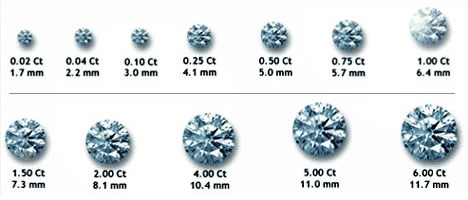
Diamonds formed deep within the earth, under extreme heat and pressure. Therefore; they often contain unique birthmarks, internal inclusion or external blemish. It is extremely rare for diamonds without sign of inclusions. Less inclusions and blemishes can hinder the light as it passes through diamond. Below are GIA clarity scale uses to grade diamond base on 10x magnification

-
F = Flawless = No inclusions or blemishes are visible to a skilled grader using 10× magnification
-
IF = Internal Flawless = No inclusions and only blemishes are visible to a skilled grader using 10× magnification
-
VVS1 - VVS2 = Very Very Slightly Included = Inclusions are difficult for a skilled grader to see under 10× magnification
-
VS1 VS2 = Very Slightly Included = Inclusions are clearly visible under 10× magnification but can be characterized as minor
-
SI1-SI2 = Slightly Included = Inclusions are noticeable to a skilled grader using 10× magnification
-
I1, I2, I3 = Included = Inclusions are obvious under 10× magnification and may affect transparency and brilliance
The cut of a diamond refers not only to the shape of the diamond and number of facets, but also to the quality of the cut. A diamond with uneven or poorly proportioned facets won't be given the same grade of cut as an ideally proportioned and masterfully cut stone. Cut of any diamond has three attributes: brilliance (the total light reflected from a diamond), fire (the dispersion of light into the colors of the spectrum), and scintillation (the flashes of light, or sparkle, when a diamond is moved). The 58-facet round brilliant cut is the most popular because of its fire and brilliance. This is achieved by cutting the stone to very exacting mathematically-determined proportions so as much light as possible is reflected out the top of the diamond. “Nail Head” will happen when deep cut. If the cut is shallow then there is sign of “Fish Eyes”.
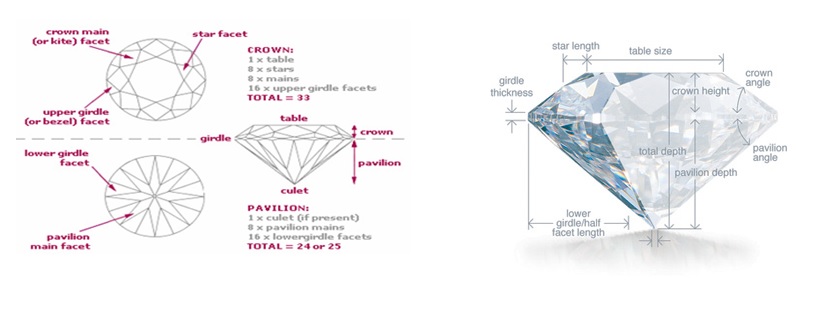
Ideal Cut:
Ideal cut is an objective measure of a diamond's light performance, or sparkle. When a diamond is cut with the proper proportions, light is returned out of the top of the diamond

Deep Cut:
If cut is too deep and it escapes out of the side (NAIL HEAD)

Shallow Cut:
If cut is too shallow, light leaks out of the bottom (FISH EYE)

Most beautiful color for diamond is colorless (no color at all). GIA has created a scale to measure diamond color ranging from D, represent for colorless to Z, near colorless. The color graded by comparing stone with Color Grading Scale under day light This process is extremely importance because slightly differences make a very big different in diamond quality and price.


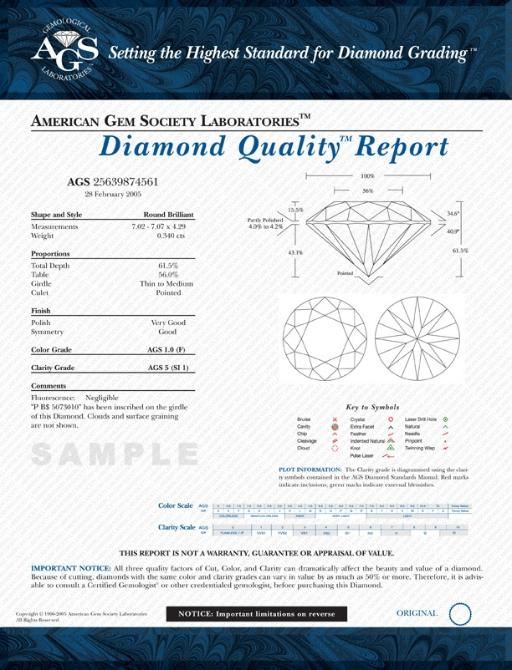

Gemstones
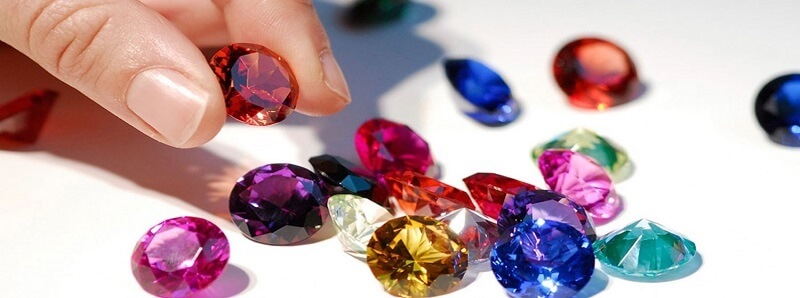
Long before diamonds were found worthy of jewelry, sapphires, rubies, emeralds were used to represent for royalty, elegance, power and romance. Kings and queens would have gemstones set in their crowns to obtain their potencies. Britain’s Prince Charles gave a blue sapphire engagement ring to Lady Diana Spencer. They connected the monarchs with forces enabling them to rule guided by cosmic energies. Priests of different religions used gems in rings for similar reasons. Today, gemstones are still loved for their beauty and personality. Celebrity people have used colored stones to express themselves in public. Gems exhibit their power in a beneficial depending on how they are used.
In addition, almost all colored gems were believed to have special powers or cure specific illnesses. gemstones are also recognized by modern science such as their power ability to promote physical healing in the body, or their power to help balance human emotions, elude modern science. They are storehouses of empowerment, transmitted through contact with one’s body. The primary use for gems throughout history has been for healing and spiritual rituals. Although gems were rare and exhibited great beauty, the reason they were so precious was due to the power they imparted to their wearers and also to express fashion, love, passion and power.
Knowledge about gemstone’s colors are the most important issue to help choosing the best color with reasonable price. Unlike diamond, cut is most important. But in gemstone, the color is the most important and can dominate 60% of its price. GIA has many years of research to find the common universal colored stone grading system but it does not work very well with the market due to the diversity of colors, different tastes of people. Therefore; just choose the best colors you like to match with your clothes and styles.
Agate
One of the first gem materials found more than 3000 years ago. They believe provided the wearer with a bold heart and pleasant dreams
Sources: Brazil, India, Madagascar, Mexico, United States, Uruguay
Hardness: 6.5 – 7 on Mohs scale
Care and Cleaning
| Steam cleaning |
Not recommended |
| Ultrasonic Cleaning |
Not recommended |
| Warm, soapy water |
Safe |
Alexandrite
Dramatic color change is sometimes described as “emerald by day, ruby by night.” It was first discovered in 1830 in Russia’s Ural Mountains. The gem was named after the young Czar Alexander II and it caught the country’s attention because it’s red and green colors mirrored the Imperial Russian flag.
Sources: Brazil, East Africa, Russia, Sri Lanka
Hardness: 8.5 on Mohs scale
Care and Cleaning
| Steam cleaning |
Usually safe |
| Ultrasonic Cleaning |
Usually safe |
| Warm, soapy water |
Safe |
Almandite
Almandite was found and named for Alabanda, an ancient Asian town back as 3100 BC. Noah is said to have recognized garnet’s inner fire and used it as a lamp on the bow of the ark.
Sources: Brazil, India, Madagascar, Pakistan, Sri Lanka, United States
Hardness: 7-7.5 on Mohs Scale
Care and Cleaning
| Steam cleaning |
Usually safe |
| Ultrasonic Cleaning |
Never |
| Warm, soapy water |
Safe |
Amber
Amber formed million years ago, when sap from ancient trees hardened and fossilized. Amber is sometimes called “Gold of the North.”
Sources: Dominican Republic, Germany, Mexico, Poland, Russia
Hardness: 2 – 2.5 on Mohs Scale
Care and Cleaning
| Steam cleaning |
Never |
| Ultrasonic Cleaning |
Never |
| Warm, soapy water |
Safe but hard brushes may scratch |
Amethyst
Most prize member of quartz. Early Greek legends, and its wine-purple color, associated amethyst with Bacchus, the god of wine. Other legends led to beliefs that amethyst gems kept their wearers clear-headed and quick-witted in battle and in their business affairs. Fine amethyst adorns the fingers of bishops and the coronation regalia of British royalty.
Sources: Brazil, India, Namibia, Sri Lanka, United States, Uruguay, Zambia
Hardness: 7 on Mohs scale
Care and Cleaning
| Steam cleaning |
Not recommended |
| Ultrasonic Cleaning |
Usually safe |
| Warm, soapy water |
Safe |
Aquamarine
Name comes from the Latin for “sea water.” Medieval sages prescribed water touched by aquamarine for a host of ills, including those affecting the eyes and lungs. They promised the virtues of insight and foresight to the gem’s wearers.
Sources: Australia, Brazil, China, Kenya, Madagascar, Mozambique, Nigeria, Pakistan, United States, Zambia
Hardness: 7.5 - 8.5 on Mohs scale
Care and Cleaning
| Steam cleaning |
Usually safe unless stone contains feathers or liquid inclusions |
| Ultrasonic Cleaning |
Usually safe unless stone contains feathers or liquid inclusions |
| Warm, soapy water |
Safe |
Bloodstone
The ancient Greeks named it heliotrope (“sun-turner”) because they observed that it flashed scarlet when they lowered it into water and pointed it toward the sun. Many people thought it colored water red for the same reason. Citizens of Medieval and Renaissance Europe honored bloodstone as a talisman that stirred passion, stopped bleeding, and brought healing
Sources: Australia, Brazil, China, India, United States
Hardness: 6.5 - 7 on Mohs scale
Care and Cleaning
| Steam cleaning |
Not recommended |
| Ultrasonic Cleaning |
Not recommended |
| Warm, soapy water |
Safe |
Carnelian
Gem specialists believe it was named after the kornel cherry, which grows in the same warm shades as the gem. Ancient civilizations believed that carnelian transformed poor or timid speakers into eloquent ones.
Sources: Brazil, India, Uruguay
Hardness: 6.5 - 7 on Mohs scale
Care and Cleaning
| Steam cleaning |
Usually safe |
| Ultrasonic Cleaning |
Usually safe |
| Warm, soapy water |
Safe |
Cat’s Eye
Gem with its band of reflected light across the middle, has always reminded observers of the eye of a cat. The gem was once known as cymophane-Greek for “waving light.” In some cultures, its distinctive appearance made it the preferred treatment for all sorts of eye ailments.
Sources: Brazil, East Africa, Sri Lanka
Hardness: 8.5 on Mohs scale
Care and Cleaning
| Steam cleaning |
Usually safe |
| Ultrasonic Cleaning |
Usually safe |
| Warm, soapy water |
Safe |
Black Chalcedony
Chalcedony is one of the world’s oldest, most abundant and most popular gems. It was named for the ancient Turkish seaport of Chalcedony (now called Kadikoy). Natural black chalcedony is extremely rare. Dyed black chalcedony which is more common, “black onyx.” This gem was prominent in the Art Deco jewelry of the 1920s and 1930s. Many cultures have used it for a variety purposes. Greek sailors wore chalcedony amulets as protection against drowning. As late as the 1700s, many Europeans believed chalcedony would drive away ghosts and bad spirits.
Sources: Brazil, Australia, Czech Republic, Germany, Iceland, Mexico, Russia, Scotland, United States
Hardness: 6.5 - 7 on Mohs scale
Care and Cleaning
| Steam cleaning |
Usually safe |
| Ultrasonic Cleaning |
Usually safe |
| Warm, soapy water |
Safe |
Citrine
Its name was derived from the Latin word citrus, meaning “citron” (a fruit closely related to the lemon). This gem combines a warm, attractive color with good wearability.
Sources: Brazil, Bolivia, Spain
Hardness: 7 on Mohs scale
Care and Cleaning
| Steam cleaning |
Not recommended |
| Ultrasonic Cleaning |
Usually safe |
| Warm, soapy water |
Safe |
Coral
For thousand years of culture and around the world have prized coral as a gem and credited this product of the sea with magical powers. First century Romans used it to ward off evil and to impart wisdom. It is still worn in modern-day Italy as protection against the “evil eye” and as a cure for sterility.
Sources: Japan, Malaysia, Philippines
Hardness: 3 – 4 on Mohs scale
Care and Cleaning
| Steam cleaning |
Never |
| Ultrasonic Cleaning |
Usually risky |
| Warm, soapy water |
Safe |